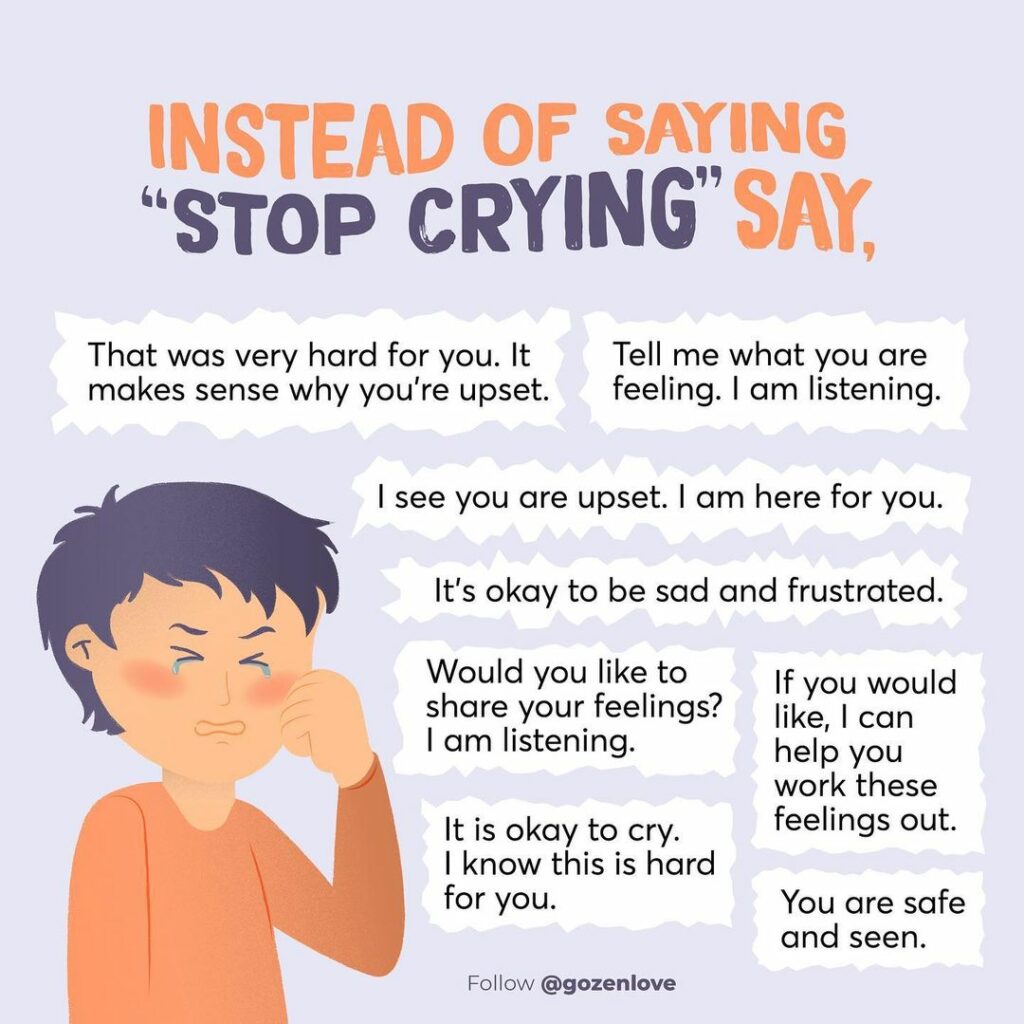Big emotions from kids can sometimes make big people uncomfortable. Especially if these big feelings involve tears. They may even provoke a command to Stop crying!
While those words may seem like the best option to get things under “control”, shutting down feelings can make our children feel uncomfortable expressing themselves both now and in the future. What’s the alternative?
We’re glad you asked. 🙂 Here are 8 things you can help your kids navigate through tears.

1. That was very hard for you. It makes sense why you’re upset.
Sometimes crying is just about recognition. When you recognize (sincerely!) that an event was tough for your child, you’re showing them that their feelings are valid, that they are seen, and that their feelings are normal and acceptable.
2. Tell me what you are feeling. I am listening.
Tears say a lot. But words can say even more. If a hurt or sad child wants to be heard, letting them know that you’re available and ready to listen can open up the door for better communication. And with practice, words will start to flow from them long before tears.
3. I see you are upset. I am here for you.
Sadness can be a lonely feeling. And it can mean so much to an upset child just to know that you’re there. It’s possible that they don’t want or need to talk. It’s possible that they’d rather be alone. But letting them know that you’re available to them provides comfort and security.
4. It’s okay to be sad and frustrated.
This phrase, in some ways, is the exact opposite of “don’t cry.” By giving them permission to be upset and cry it out, you’re validating your child’s feelings and letting them know that no matter what they feel, they’re accepted and loved. But it’s not just your acceptance they need. In tough moments, your child may try to deny their own difficult feelings (totes normal). Telling them that it’s ok to feel their emotions—even tough ones—can foster a sense of self-acceptance.
5. Would you like to share your feelings? I am listening.
Be prepared with this one—your child may say no, and that’s ok. Letting them know that you’re ready and available to listen means your child knows that you’re there for them when they want to work through their issue.
6. It is okay to cry. I know this is hard for you.
Who doesn’t need a good cry once in a while? I know I do. But the stigma of crying can be difficult to overcome, especially depending on your child’s age and gender. Letting your little one know that it’s ok to cry (and even reminding them that you cry sometimes, too) can provide your child with the safety they need to express their emotion and talk to you about what they’re feeling.
7. If you like, I can help you work these feelings out.
Feeling are confusing. It’s hard to know what they mean, where they come from, or what they’re trying to tell you. And kids feel this more than anyone. They’re just not equipped to always understand what’s happening inside their bodies and minds. Let them know that it takes work to understand feelings, and you’re there to help them puzzle it out.
8. You are safe and seen.
Sometimes, your child may just need a reminder that they’re in a safe space. They may not want to talk or figure out a solution, and that’s ok. Letting them know that they’re accepted, loved, and in no danger may be all they need to support them in getting through tough emotions.
The bottom line is that you are your child’s comfort zone when it comes to expressing difficult emotions. Making it clear that it’s ok to cry can set the stage for your child opening up to you about more difficult topics as they grow and life becomes more complicated. If you’re looking for more resources for your children to help them manage their own emotions, check out the Calm Down Corner Kit, and teach them to recognize their feelings, reflect on what they mean, and resolve to take positive action!